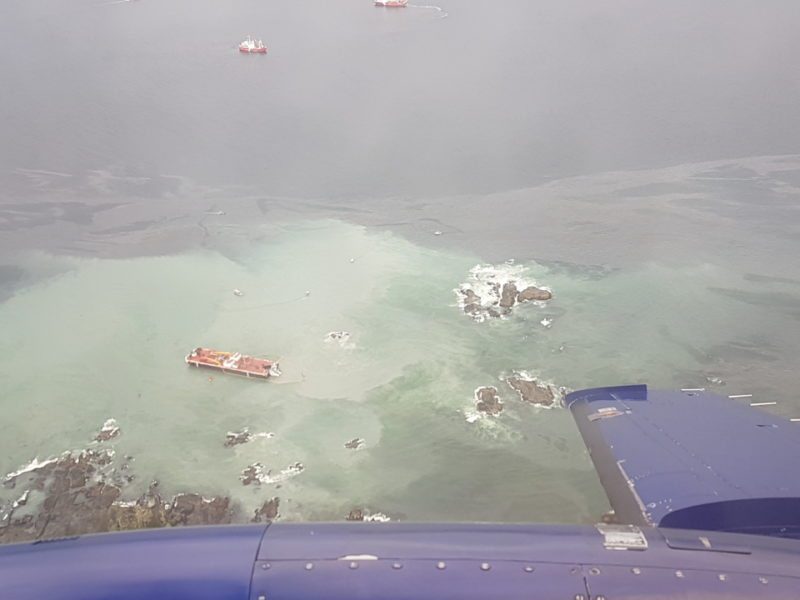India Seeks $1.1 Billion Reparation After MSC Fuel Spill in May
The southern Indian state of Kerala has sued MSC Mediterranean Shipping Co. for the environmental damages caused by a ship capsizing off its coast, according to a court document.

The wreck of the Nathan E. Stewart near Bella Bella, British Colombia, October 13, 2016.
The investigation revealed that the second mate, who was alone on the bridge at the time of the accident, had fallen asleep after working a 6-on, 6-off shift schedule for at least two days leading up to the grounding.
The Transportation Safety Board of Canada (TSB) has released its investigation report into the October 2016 grounding and sinking of the American tug Nathan E. Stewart near Bella Bella in British Columbia, Canada, listing crew fatigue as the main factor in the incident.
The Board also determined that the spill response was adequate, but noted Canada’s spill response regime could be improved.
On 13 October 2016, shortly after 1 a.m. Pacific Daylight Time, the U.S-flagged articulated tug-barge (ATB) composed of the tug Nathan E. Stewart and a tank barge, DBL 55, went aground on Edge Reef near Athlone Island, at the entrance to Seaforth Channel, approximately 10 nautical miles west of Bella Bella, British Columbia, within the Heiltsuk First Nation territory.
The tug’s hull was eventually breached and approximately 110,000 liters of diesel fuel were released into the environment. The tug subsequently sank and separated from the barge.
The tug and barge were owned by Houston-based Kirby Offshore Marine Operating. At the time of the accident, the ATB was underway from Ketchikan, Alaska to Vancouver, British Columbia, with 7 crew members on board.
The Nathan E. Stewart was eventually removed from the area about a month later.

The investigation determined that the second mate who, contrary to Canadian regulations, was keeping watch alone on the bridge at the time of the accident, had fallen asleep and missed a planned course change.
The investigation further revealed that for more than two days, he had been working a 6-on, 6-off shift schedule, alternating six hours of duty and six hours of rest. This schedule presents a number of challenges which have been well documented by various studies and experts internationally, notably the difficulty in obtaining sufficient restorative rest during the off-duty periods, the TSB stated.
There was also no prior discussion with the master on the second mate’s preparedness for the watch, and the watchkeeper wasn’t aware of the sleep-conducive conditions he was facing on the bridge that night, the TSB said.
The TSB said the report underlines the need to effectively and reliably manage the risk of fatigue in the marine industry, noting that it has identified fatigue as a causal or contributory factor in numerous marine investigations.
“There is a compelling need for vessel operators and watchkeepers to recognize and to address the factors that contribute to fatigue,” said Kathy Fox, Chair of the TSB. “If watchkeepers have a better understanding of those factors, and the actions they can take to reduce the risks, then we should see a reduction in the number of fatigue-related occurrences in the marine industry.”
The Board has made two recommendations following this investigation.
First, it is recommending that Transport Canada require that watchkeepers receive mandatory education and awareness training to help identify and prevent the risks of fatigue.
Second, it is also recommending that vessel owners implement comprehensive fatigue-management plans, tailored specifically for their individual operations.
The investigation also determined that the spill response and the recovery efforts of both the Western Canada Marine Response Corporation and the Canadian Coast Guard were in accordance with the prescribed time standards.
“However, because other responding agencies and some Canadian Coast Guard personnel were not familiar with the incident command system in use, there was confusion about roles and responsibilities and who had final authority,” the TSB said. “A coordinated and comprehensive evaluation of the response involving all organizations may have provided more insight to identify deficiencies and improve Canada’s spill response regime.”
Transportation Safety Board of Canada’s full report on the investigation can be found here.

Sign up for gCaptain’s newsletter and never miss an update

Subscribe to gCaptain Daily and stay informed with the latest global maritime and offshore news


Stay informed with the latest maritime and offshore news, delivered daily straight to your inbox
Essential news coupled with the finest maritime content sourced from across the globe.
Sign Up